Select Language
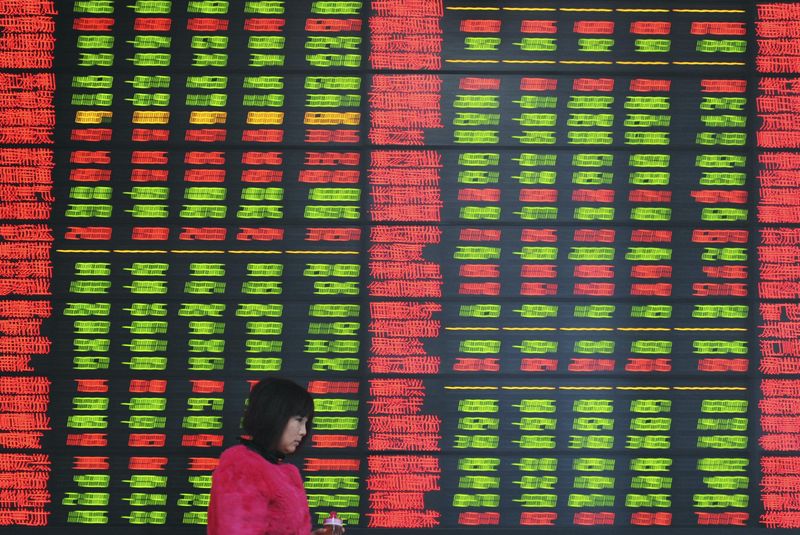
Investing.com-- Most Asian stocks rebounded on Wednesday amid hopes that U.S. President Donald Trump may negotiate the steep tariffs imposed on Mexico, Canada, and China, just a day earlier, while Australian shares declined despite data showing robust economic growth in the fourth quarter.
Regional equities also drew cues from a jump in U.S. stock index futures in Asia hours. Major U.S. stock indexes ended sharply lower on Tuesday after Trump’s announcement.
Asia stocks get respite from prospects tariff negotiations
On Tuesday, President Trump escalated trade tensions by imposing substantial tariffs on imports from Canada, Mexico, and China.
A 25% tariff was levied on Canadian and Mexican goods, while tariffs on Chinese products were increased to 20%.
These measures prompted swift retaliatory actions as Canada announced immediate 25% tariffs on U.S. imports worth C$30 billion, and China imposed 15% tariffs on U.S. agricultural imports, including chicken and wheat, along with 10% on products like soybeans and pork.
In an interview with Fox Business on Tuesday, U.S. Commerce Secretary Howard Lutnick indicated that President Trump might be open to negotiations to resolve the escalating trade disputes.
This suggestion of potential dialogue introduced a degree of optimism in global markets.
Japan’s Nikkei 225 rose 0.5% on Wednesday, while TOPIX was largely unchanged.
Hong Kong’s Hang Seng index jumped 1.5%, rebounding from steep losses in the previous session.
Indonesia’s Jakarta Stock Exchange Composite Index jumped 2.9%, leading the gains among regional bourses.
Singapore’s Straits Times Index gained 0.3%, while Malaysia’s KLCI index rose 0.6%.
South Korea’s KOSPI jumped 0.9%.
India’s Nifty 50 edged 0.2% higher at open on Wednesday.
Australia’s Q4 GDP grows more than expected
Data on Wednesday showed that Australia’s Gross Domestic Product (GDP) grew by 0.6% in the fourth quarter of 2024, surpassing the previous quarter’s 0.3% growth and exceeding market expectations of 0.5%.
On an annual basis, GDP increased by 1.3%, up from 0.8% in the third quarter, driven by strong public and private investment, as well as a rebound in the terms of trade.
Despite the positive data, Australia’s S&P/ASX 200 index was trading 0.8% lower, as local investors were assessing the impact of tariffs on Australia’s biggest trade partner China.
China targets 5% GDP growth in 2025; parliamentary meeting in focus
China’s Shanghai Composite rose 0.3%, while the Shanghai Shenzhen CSI 300 index gained 0.4%.
China has set a 2025 economic growth target of around 5%, media reports said, citing official documents.
Premier Li Qiang will present it at the National People’s Congress, which began on March 5.
Amid U.S. tariffs and trade tensions, China plans fiscal measures, including a higher budget deficit and 1.3 trillion yuan in special treasury bonds, reports stated.
China’s annual parliamentary meeting, also known as "Two Sessions", is being held from March 5 to March 11 this week in Beijing.

Investing.com-- Oil prices fell slightly in Asian trade on Wednesday as markets remained on edge over tariff-related headwinds and increasing global production, with focus turning to stimulus measures in top importer China.
Prices had tumbled to a five-month low on Tuesday as investors fretted over worsening demand amid economic headwinds from increased U.S. trade tariffs. This came as U.S. President Donald Trump delivered on his threats of higher tariffs against China, Canada, and Mexico.
Oil markets were also rattled by reports that the Organization of Petroleum Exporting Countries and allies (OPEC+) will proceed with a plan to begin increasing production, albeit marginally, from April.
Still, crude prices found some relief from China- the world’s biggest oil importer- setting a 5% economic growth target for 2025 while outlining a slew of stimulus measures. Industry data also showed a bigger-than-expected draw in U.S. inventories.
Brent oil futures expiring in May fell 0.2% to $70.93 a barrel, while West Texas Intermediate crude futures fell 0.3% to $67.46 a barrel by 20:51 ET (01:51 GMT). Both contracts remained close to a five-month low hit earlier this week.
China targets 5% GDP, outlines stimulus plans
China set a gross domestic product target of 5% for 2025, keeping the figure unchanged for a third consecutive year.
The figure was revealed at the opening of the annual meeting of the National People’s Congress, China’s most important political meeting.
Beijing outlined a higher budget deficit for 2025, heralding more fiscal spending, and also promised more action to boost local consumption, which has been a major point of pressure on local growth.
Beijing will also ramp up its debt issuance in 2025 to allocate more resources towards consumer subsidies.
US inventories see bigger-than-expected draw- API
Data from the American Petroleum Institute showed that U.S. oil inventories shrank nearly 1.5 million barrels in the week to February 28, more than expectations for a draw of 0.3 mb.
The reading usually heralds a similar print from official inventory data, which is due later on Wednesday. U.S. inventories shrank last week after four straight weeks of outsized builds.
But signs of a draw in the past week raised some hopes that fuel demand was improving and U.S. supplies were tightening.
Oil prices were battered by Trump also calling on higher energy production, domestically and abroad.
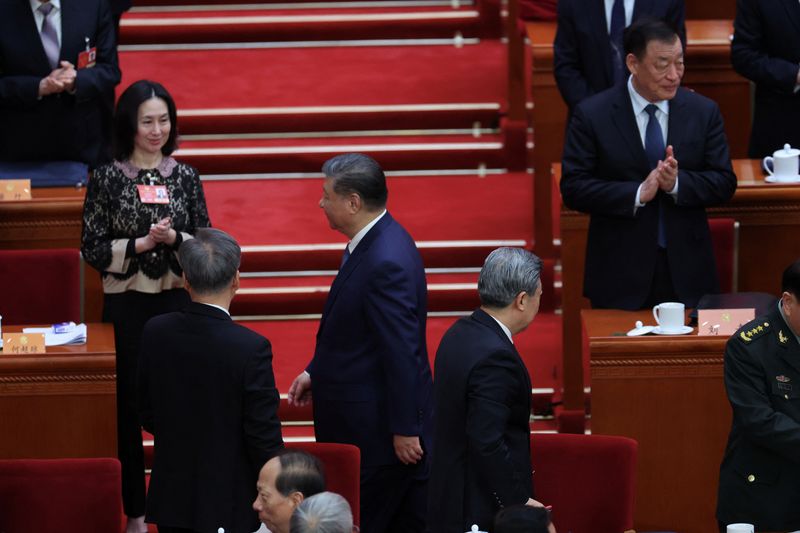
By Antoni Slodkowski
BEIJING (Reuters) - China kept its economic growth target for this year unchanged at roughly 5%, committing more fiscal resources than last year to fend off deflationary pressures and mitigate the impact of rising U.S. trade tariffs.
The target, which confirms a December Reuters report, was included in a government document prepared for the annual meeting of the National People’s Congress (NPC), China’s rubber-stamp parliament.
Premier Li Qiang will deliver a speech at the NPC later on Wednesday, detailing China’s policies for the rest of the year.
An escalating trade war with U.S. President Donald Trump’s administration is threatening to crimp China’s economic jewel, its sprawling industrial complex, at a time when persistently sluggish household demand and the unravelling of the debt-laden property sector are leaving the economy increasingly vulnerable.
Trump has also dangled tariffs at a long list of countries, including some which would consider themselves staunch U.S. allies, threatening a decades-old global trade order that Beijing has built its economic model around.
Pressure has been building on Chinese officials to introduce policies that put more money into consumers’ pockets and reduce the world’s second-largest economy’s reliance on exports and investment for growth.
China also aims for a budget deficit of 4% of gross domestic product (GDP) in 2025, up from 3% in 2024, showed the report, which promised a "special action plan" to stimulate consumption.
Beijing plans to issue 1.3 trillion yuan ($179 billion) in special treasury bonds this year, up from 1 trillion in 2024. Local governments will be allowed to issue 4.4 trillion yuan in special debt, up from 3.9 trillion.
From the central government’s special debt funds, 300 billion yuan will support a recently-expanded consumer subsidy scheme for electric vehicles, appliances and other goods.
Economists have been urging Beijing to engineer a long-term restructuring of resource allocation in the economy with more profound measures that reimagine its taxation, land and financial systems to weave a stronger social safety net.
"With deflationary pressures becoming entrenched against the background of an unfavourable external environment ... boosting domestic household consumption demand is a key priority," said Eswar Prasad, trade policy professor at Cornell University and a former China director at the International Monetary Fund.
"One-off schemes might help at the margin, but durable measures to provide income support and strengthen the safety net are essential."
Beijing also plans to use 500 billion yuan of the special debt funds to re-capitalise major state banks and 200 billion yuan on supporting manufacturing equipment upgrades.
INNOVATION DRIVE
China’s 5% growth rate last year, which the government only reached with a late stimulus push, was among the world’s fastest, but it was hardly felt at street level.
While China runs a trillion dollar annual trade surplus, many of its people are complaining of unstable jobs and incomes as their employers cut prices - and business costs - to stay competitive in external markets.
Chinese producers, facing weak demand at home and harsher conditions in the United States, where they sell more than $400 billion worth of goods annually, have no choice but to rush to alternative export markets all at the same time.
They fear this would intensify price wars, squeeze their profitability, and raise the risk that politicians in those new markets will feel compelled to erect higher trade barriers against Chinese goods to protect domestic industries.
Since Trump took office in January, his administration has so far added an extra 20 percentage points on existing import tariffs for Chinese goods, with the latest 10-point increment having kicked in on Tuesday.
"We worry that they will add another 10% and then another 10%," said Dave Fong, who manufactures school bags, talking teddy bears, stationery and consumer electronics in China. "That’s a big problem.”
China on Tuesday retaliated against the fresh U.S. tariffs.
Since the pandemic, China has primarily placed its future growth bets on what it calls "new productive forces" rather than on its 1.4 billion consumers, pouring resources into advanced manufacturing, hoping to close the technological gap with geopolitical rivals.
In the government report, Beijing pledged to continue supporting high-tech industries and improve investment efficiency.
Electric vehicle makers such as BYD (SZ:002594) and AI platform Deepseek have taken to the world stage with plenty of pizzazz.
But Alicia Garcia-Herrero, chief Asia Pacific economist at Natixis, says technological aspirations and consumer demand growth are "competing priorities" and finding a balance between them "will be crucial for China to avoid the prolonged stagnation experienced by Japan."
"The tangible impact of this innovation drive on growth, specifically through increased productivity, is not yet visible," she said.
"While industrial policy and technological advancement are important, China must address its fundamental imbalances."
($1 = 7.2651 Chinese yuan renminbi)
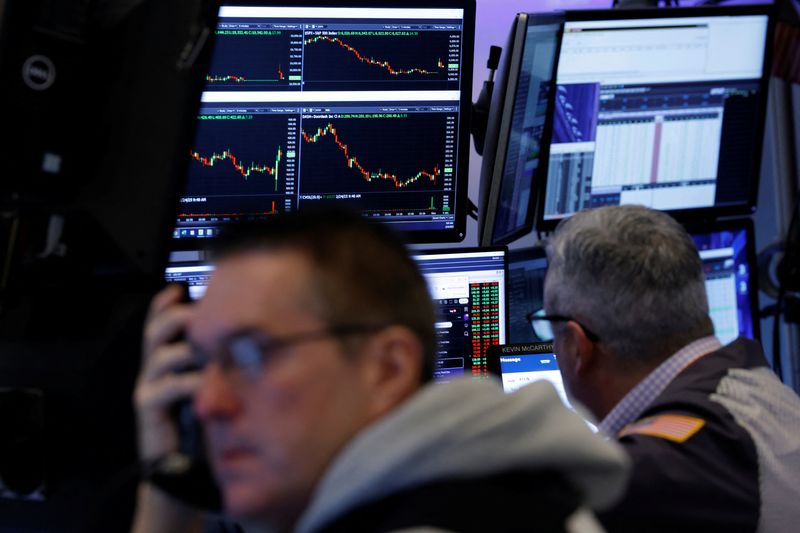
By Chibuike Oguh, Johann M Cherian and Sukriti Gupta
NEW YORK (Reuters) - U.S. stocks ended lower on Tuesday, with the tech-heavy Nasdaq veering near correction territory, as trade tensions escalated following U.S. President Donald Trump’s new tariffs on Canada, Mexico and China.
The 25% tariffs on imports from Mexico and Canada, along with doubled duties on Chinese goods, took effect on Tuesday. China and Canada retaliated while Mexican President Claudia Sheinbaum vowed to respond likewise, without giving details.
The Nasdaq Composite ended lower after veering into correction territory during the session but pared losses in choppy trading. The index closed down 9.3% from its record closing high on December 16.
"Equity valuations have been very elevated and there’s been yellow flags all over the horizon given moves to cut government spending," said Ben McMillan, chief investment officer at IDX Insights in Tampa, Florida. "Now on top of that, we have all this rhetoric around tariffs."
Shares in financials and industrials were the biggest losers among the benchmark S&P 500’s 11 main sectors.
Citigroup (NYSE:C) and JPMorgan Chase & Co (NYSE:JPM) fell 6.2% and nearly 4%, respectively, sending the bigger banks index down 4.7%.
The CBOE market volatility index rose 3.20% to its highest since December 20.
"The fear here is that it’s going to slow (economic) growth," said Adam Sarhan, CEO of 50 Park Investments in New York. "And when you have a slowdown in economic conditions, it’s a situation where banks specifically make less money because fewer goods and services are traveling through the economy."
The Dow Jones Industrial Average fell 670.25 points, or 1.55%, to 42,520.99, the S&P 500 lost 71.57 points, or 1.22%, to 5,778.15 and the Nasdaq Composite lost 65.03 points, or 0.35%, to 18,285.16.
Car makers Ford (NYSE:F) and General Motors (NYSE:GM), which have vast supply chains across North America, fell 2.9% and 4.6%, respectively. The domestically focused Russell 2000 index dropped 1%.
Wall Street is really concerned, McMillan said. "The likelihood of tariffs will lead to higher prices and therefore lower spending."
Target shares fell 3% after the retailer forecast full-year comparable sales below estimates.
Best Buy (NYSE:BBY) slumped 13.3% after the electronics retailer issued a downbeat forecast, while Walgreens jumped as a report hinted that the pharmacy chain is closing in on a take-private deal by Sycamore Partners.
Declining issues outnumbered advancers by a 2.97-to-1 ratio on the NYSE. There were 86 new highs and 450 new lows on the NYSE.
The S&P 500 posted 41 new 52-week highs and 43 new lows while the Nasdaq Composite recorded 35 new highs and 595 new lows.
Total volume across U.S. exchanges was 18.42 billion shares, compared with the 20-day moving average of 15.87 billion shares.

By Ariba Shahid
KARACHI (Reuters) -Pakistan's annual inflation rate slowed to 1.5% in February, the lowest in nearly a decade and below the finance ministry's estimates, data from the statistics bureau showed on Monday.
Inflation has cooled significantly, easing from 23.1% in February 2024.
Consumer prices in February fell 0.8% from the month before, according to the Pakistan Bureau of Statistics.
The South Asian country, currently bolstered by a $7 billion facility from the International Monetary Fund (IMF) granted in September, is navigating an economic recovery.
Authorities have credited inflation's downward trend to economic stabilization under a the IMF programme.
Pakistan's finance ministry, in its monthly economic outlook report released last week, predicted inflation would stabilize in February between 2.0-3.0%, continuing its downward trend from the previous year. The ministry also forecast a slight increase to 3.0-4.0% by March 2025.
"A favorable base effect from last year's high inflation contributed to this result. We anticipate an uptick in food inflation during Ramzan," said Waqas Ghani, head of research at JS Global, adding that the data was primarily driven by a decline in food inflation, with significant price drops in staples.

Investing.com-- China on Tuesday announced tariffs on U.S. goods and a slew of other trade measures in retaliation for an increased, 20% trade tariff imposed by U.S. President Donald Trump against the country.
China’s finance ministry said it will impose tariffs of 15% on chicken, wheat, corn, and cotton imports from the U.S., while soybeans, sorghum, pork, beef, fruits and vegetables, aquatic products, and dairy will face a 10% tariff.
China’s Commerce Ministry added 15 U.S. entities to an export control list and added 10 U.S. firms to a list of unreliable entities. The measures will take effect from March 10.
One of the companies targeted by Beijing was Illumina Inc (NASDAQ:ILMN), which is now banned from exporting gene sequencing machines to China.
The retaliatory measures came as Beijing decried Trump’s decision to raise import tariffs on all Chinese goods to 20% from 10%. Trump’s increased tariffs came into effect from 00:00 ET (05:00 GMT) on Tuesday.
Trump said the increased tariffs were aimed at pressuring China into stemming the flow of illegal substances, particularly fentanyl, into U.S. territory. Trump also imposed 25% tariffs against Canada and Mexico on similar grounds, while calling on the two to increase their border controls.
Trump had imposed 10% tariffs on China in February, which had seen Beijing retaliate with its own tariffs and export controls. Tuesday’s tariffs, along with China’s retaliation, potentially mark the escalation of a trade war seen between the world’s biggest economies.
Trump’s first presidency was also marked by a bitter trade war with China, although tensions tapered off with the signing of a trade deal in 2019.
Washington and China have expressed interest in hashing out a new trade agreement in recent months.
Trump’s new tariffs also come just before the beginning of a top-level government meeting in China this week. The country is expected to dole out more stimulus measures to help its economy weather the impact of higher tariffs.

Investing.com-- The U.S. has halted all military aid to Ukraine, a slew of media reports showed on Monday evening, after a fiery meeting between President Donald Trump and his Ukrainian counterpart Volodymyr Zelensky over the weekend.
The White House said it was pausing and reviewing its aid to ensure that its efforts were contributing towards peace, reports from Reuters and the Wall Street Journal showed.
It was not immediately clear how the White House planned to gauge a move towards peace, or what its demands were from Kyiv. Earlier reports showed Trump was pushing for a mineral export deal with Ukraine.
Monday’s move to stop aid comes after a contentious meeting between Zelensky, Trump, and U.S. Vice President J.D. Vance over the weekend. It also marks the most definitive shift yet in the U.S.’ stance towards Ukraine, after it provided hundreds of billions in aid to Kyiv over the past three years to stave off a Russian invasion.
Trump had earlier on Monday lashed out against Zelensky for suggesting that the war with Russia could continue for longer. The U.S. President had earlier called Zelensky a “dictator,” while criticizing him for prolonging the war with Russia, despite Moscow having attempted an invasion in 2022.
A lack of U.S. military aid is expected to diminish Ukraine’s ability to defend itself against Russia. But a slew of European nations were seen expressing support for Kyiv after Zelensky’s meeting with Trump.
Trump had in February said his administration was working on a peace deal between Russia and Ukraine, although the terms of said deal remained unclear. It also appeared that Kyiv was not privy to these negotiations.

Investing.com-- Oil prices fell to a near three-month low in Asian trade on Tuesday amid heightened concerns over economic disruptions from higher U.S. trade tariffs, while the prospect of increased OPEC+ production also weighed.
Oil found little relief this week after falling sharply on the prospect of a worsening trade war between the world’s biggest economies. The prospect of more economic pressure on China- the world’s biggest oil importer- also weighed, after U.S. President Donald Trump hiked tariffs against the country to 20%.
This was exacerbated by fears of increased supply, after the Organization of Petroleum Exporting Countries and allies (OPEC+) said it will increase supply in April.
Trade and supply jitters saw markets largely look past signs of a potential escalation in the Russia-Ukraine war, after the U.S. on Monday halted all military aid to Ukraine.
Brent oil futures expiring in May fell 0.8% to $71.07 a barrel, while West Texas Intermediate crude futures fell 0.% to $67.64 a barrel by 20:40 ET (01:40 GMT).
Trump tariffs roil markets
Trump on Monday hiked his tariffs against China to 20%, and said his 25% tariffs on Canada and Mexico will proceed, with all three duties set to take effect later on Tuesday.
News of the tariffs sparked deep losses across financial markets, with oil prices being no exception. Markets fretted that disruptions in global trade could undermine economic growth, in turn hurting demand for oil.
Trump’s tariffs on China have been a key point of concern for oil, given that they present more economic headwinds for the world’s biggest oil importer. China is also expected to retaliate with its own trade measures, escalating a trade war with the U.S.
OPEC+ to proceed with April production hike
The OPEC+ signaled on Monday that it will proceed with a planned oil output increase in April, amid pressure from Trump to increase production and bring down prices.
Increased OPEC+ production heralds less tight oil markets in the coming months, which stand to pressure oil prices.
This also comes against a backdrop of cooling oil demand across the globe, as several major economies grapple with slowing growth, sticky inflation and cooling consumer sentiment.
Still, the OPEC+’s initial increases in production are expected to be marginal- at about 138,000 barrels per day. The figure is only a fraction of the 5.8 mln bpd cut by the cartel since 2022.
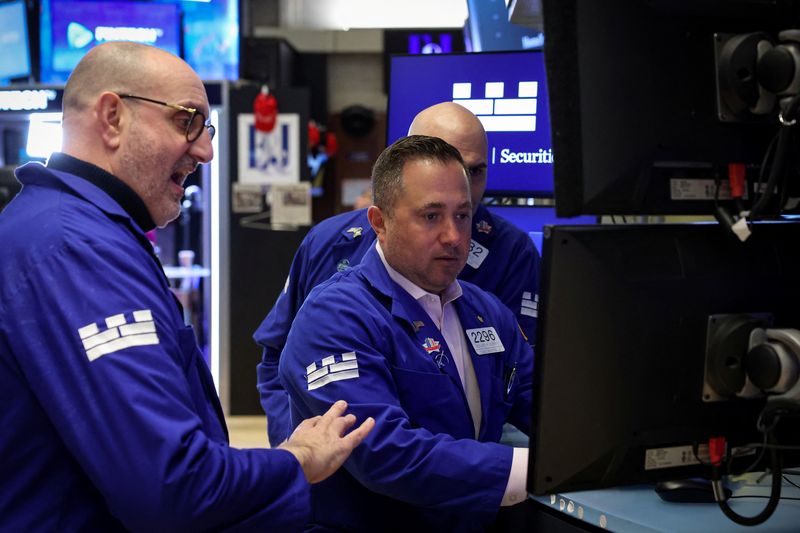
By Johann M Cherian, Sukriti Gupta and Chibuike Oguh
NEW YORK (Reuters) -Wall Street’s main stock indexes closed sharply lower on Monday after President Donald Trump announced the start of 25% tariffs on Canada and Mexico, with the S&P 500 posting its biggest daily percentage decline since December 18.
Stocks had already slipped after an ISM survey, and they extended losses after Trump said 25% tariffs on Canada and Mexico will go into effect on Tuesday with reciprocal tariffs starting April 2. He said the North American countries had "no room left" to avert the tariffs.
"Markets were looking for another 11th hour deal to further delay tariffs, but aren’t going to get one this time," said Jamie Cox, managing partner at Harris Financial Group. "The threat of tariffs has run its course for now, so the next phase is to endure them. Markets have to price that reality, and those numbers are painted red."
The ISM survey showed manufacturing PMI slipped to 50.3 last month from 50.9 in January, while the forward-looking new orders index contracted to 48.6 in February from 55.1 in January. The dip in the PMI mirrored declines in other sentiment measures as investors worried about tariffs.
"I think it’s just more of a continuation of a string of bad economic news that tends to put a little bit of a dampener on the optimism that we saw from the fourth quarter earnings that were getting released, which were pretty good," said James St. Aubin, chief investment officer at Ocean Park Asset Management in Santa Monica, California.
Energy and technology sectors led declines among the S&P 500’s 11 sectors, with most megacap growth sectors ending down including chip giant Nvidia (NASDAQ:NVDA) - which is down 8.7%. Amazon (NASDAQ:AMZN) closed down 3.4%.Defensive sectors such as Real estate, healthcare, Utilities and consumer staples finished higher.
The Dow Jones Industrial Average fell 649.67 points, or 1.48%, to 43,191.24, the S&P 500 lost 104.78 points, or 1.76%, to 5,849.72 and the Nasdaq Composite lost 497.09 points, or 2.64%, to 18,350.19.
Recent reports of softening consumer demand have spurred fears of an economic slowdown and higher inflation. Trump is also expected on Tuesday to raise fentanyl-related tariffs on Chinese imports to 20% from 10% currently, unless Beijing ends fentanyl trafficking into the U.S. U.S.-listed shares of Chinese companies fell, with Nio (NYSE:NIO) tumbling 8.6% and JD.com dropping nearly 4%.
Worries about sticky inflation have made the Federal Reserve more cautious on interest rate cuts, but this week’s employment and business activity data could change the central bank’s view. Traders have been betting on at least two interest rate cuts of 25 basis point each from the Fed by December, according to data compiled by LSEG. Tesla (NASDAQ:TSLA) erased early gains and ended down 2.84%. Morgan Stanley had reinstated the stock as "top pick" among U.S. autos. Chipmaker Intel (NASDAQ:INTC) closed lower by 4%, erasing gains that came in early trade after a report that chip designers Nvidia and Broadcom (NASDAQ:AVGO) were running manufacturing tests with the company.
Declining issues outnumbered advancers by a 1.91-to-1 ratio on the NYSE. There were 195 new highs and 316 new lows on the NYSE. The S&P 500 posted 57 new 52-week highs and 27 new lows while the Nasdaq Composite recorded 58 new highs and 453 new lows.
The CBOE Volatility Index, also known as Wall Street’s fear gauge, rose as high as 24.31 points, touching its highest since December 20.
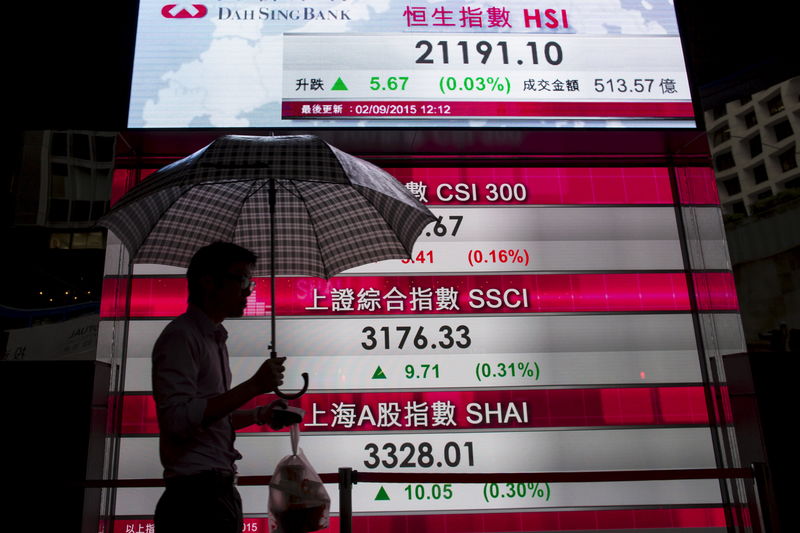
Investing.com-- Most Asian stocks fell on Wednesday as risk appetite was rattled by U.S. President Donald Trump threatening more trade tariffs, while signs of cooling economic growth also weighed.
Hong Kong markets were outliers, rising sharply as a rally in major Chinese internet stocks resumed on persistent optimism over the country’s artificial intelligence capabilities. Gains also spilled over into mainland Chinese markets.
Broader Asian markets took a weak lead-in from Wall Street, which ended lower for a fourth straight session as weak consumer confidence data fueled increased concerns over a cooling U.S. economy.
Trump added to the negative sentiment by threatening to impose tariffs on copper. He had earlier this week also signaled that 25% tariffs on Canada and Mexico will be imposed by early-March.
U.S. stock index futures rose in Asian trade, indicating that Wall Street may be due for some bargain buying. But investors remained skittish ahead of earnings from tech major NVIDIA Corporation (NASDAQ:NVDA), which are due later on Wednesday.
Hong Kong tech rally resumes
Hong Kong’s Hang Seng index was the best performer in Asian trade on Wednesday, rising more than 2% on strength in major tech stocks.
The Hang Seng was close to a two-year high, having rallied sharply over the past month as optimism over China’s AI capabilities saw investors pile into local tech stocks. Majors such as Baidu (NASDAQ:BIDU) Inc (HK:9888), Alibaba (HK:9988), and Tencent Holdings Ltd (HK:0700), were a major beneficiary of this trend.
While the tech rally was seen cooling in recent sessions, analysts still expected Chinese tech to push higher, especially as recent corporate earnings showed encouraging trends for AI adoption in the country.
Optimism over AI also benefited adjacent sectors such as semiconductors and utilities, helping drive gains in broader Chinese markets. China’s Shanghai Shenzhen CSI 300 and Shanghai Composite indexes were mildly positive on Wednesday, and were also sitting on strong gains in the past month.
Asian tech skittish with Nvidia in focus
Other Asian tech stocks were less upbeat, as investors soured on the sector- especially on companies with U.S. exposure- ahead of key earnings from Nvidia.
The stock was also nursing three days of steep losses, amid some profit-taking, and as investors turned cautious over the outlook for the AI sector.
Tech-heavy Asian bourses retreated on Wednesday, with Japan’s Nikkei 225 down 0.5%, while South Korea’s KOSPI shed 0.1%.
TSMC (TW:2330)- a major Nvidia supplier- fell 0.5% in Taiwan trade, while Hon Hai Precision Industry (TW:2317), also known as Foxconn, fell 0.3%.
Broader Asian markets mostly moved in a flat-to-low range, as weak U.S. economic data and Trump’s tariff threats kept risk appetite under pressure.
Australia’s ASX 200 fell 0.3% after consumer price index inflation data read slightly weaker than expected for January. But underlying inflation rose, while overall inflation still remained sticky, giving the Reserve Bank little impetus to cut interest rates further.
Singapore’s Straits Times index was flat, while Japan's TOPIX index fell 1.1%.

